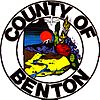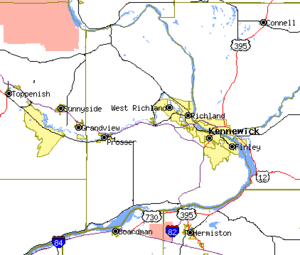Benton County, Washington facts for kids
Quick facts for kids
Benton County
|
||
|---|---|---|
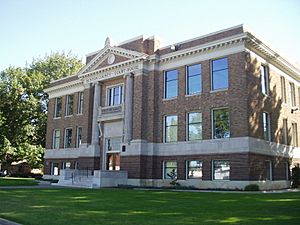
Benton County Courthouse
|
||
|
||
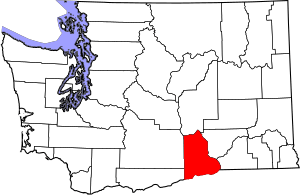
Location within the U.S. state of Washington
|
||
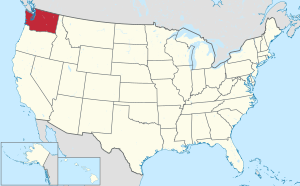 Washington's location within the U.S. |
||
| Country | ||
| State | ||
| Founded | March 8, 1905 | |
| Named for | Thomas Hart Benton | |
| Seat | Prosser | |
| Largest city | Kennewick | |
| Area | ||
| • Total | 1,760 sq mi (4,600 km2) | |
| • Land | 1,700 sq mi (4,000 km2) | |
| • Water | 60 sq mi (200 km2) 3.4%% | |
| Population
(2020)
|
||
| • Total | 206,873 | |
| • Estimate
(2021)
|
210,025 |
|
| • Density | 110/sq mi (40/km2) | |
| Time zone | UTC−8 (Pacific) | |
| • Summer (DST) | UTC−7 (PDT) | |
| Congressional district | 4th | |
Benton County is a county in the south-central portion of the U.S. state of Washington. As of the 2020 census, its population was 206,873. The county seat is Prosser, and its largest city is Kennewick. The Columbia River demarcates the county's north, south, and east boundaries.
Benton County was created from what were then larger versions of Klickitat County and Yakima County on March 8, 1905, and was named after Missouri statesman Thomas Hart Benton.
Geography
According to the U.S. Census Bureau, the county has a total area of 1,760 square miles (4,600 km2), of which 1,700 square miles (4,400 km2) is land and 60 square miles (160 km2) (3.4%) is water. The highest point of land elevation within the county is the summit of Rattlesnake Mountain at 3,527 feet; and the lowest point of land elevation is along the southwestern shore of Crow Butte at 265 feet (fluctuates due to level of Columbia River).
Waterways
- Columbia River - Surrounds and forms the county's boundary on three sides. Barge trafficking is possible upriver to anchorage sites in northern Richland, the upstream extent of Lake Wallula which forms behind McNary Dam.
- Yakima River - Bisects the county from west to east, emptying into the Columbia River at Richland. As a water source, the Yakima is the lifesource for agriculture in the Yakima Valley. A shallow river, the Yakima is suitably navigable only for small, personal watercraft. Historically, the Yakima River supported some of the most bountiful migratory fish populations in the entire Columbia Basin, and many of those legendary salmon runs are now rebounding after decades of demise. Amon Creek is the most notable tributary of the Yakima River in Benton County, emptying into the mainstem river near its estuary in Richland.
Mountains and ridges
- Horse Heaven Hills
- Rattlesnake Mountain
- Badger Mountain
- Candy Mountain
Adjacent counties
- Grant County - north
- Franklin County - northeast
- Walla Walla County - east
- Umatilla County, Oregon - southeast
- Morrow County, Oregon - southwest
- Klickitat County - southwest
- Yakima County - west
National Protected Areas
- Hanford Reach National Monument (part)
- Manhattan Project National Historical Park (part)
- Saddle Mountain National Wildlife Refuge (part)
- Umatilla National Wildlife Refuge (part)
Major highways
 Interstate 82
Interstate 82 Interstate 182
Interstate 182 U.S. Route 12
U.S. Route 12 U.S. Route 395
U.S. Route 395 Washington State Route 14
Washington State Route 14 Washington State Route 240
Washington State Route 240
Demographics
| Historical population | |||
|---|---|---|---|
| Census | Pop. | %± | |
| 1910 | 7,937 | — | |
| 1920 | 10,903 | 37.4% | |
| 1930 | 10,952 | 0.4% | |
| 1940 | 12,053 | 10.1% | |
| 1950 | 51,370 | 326.2% | |
| 1960 | 62,070 | 20.8% | |
| 1970 | 67,540 | 8.8% | |
| 1980 | 109,444 | 62.0% | |
| 1990 | 112,560 | 2.8% | |
| 2000 | 142,475 | 26.6% | |
| 2010 | 175,177 | 23.0% | |
| 2020 | 206,873 | 18.1% | |
| 2021 (est.) | 210,025 | 19.9% | |
| U.S. Decennial Census 1790–1960 1900–1990 1990–2000 2010–2020 |
|||
2010 census
As of the 2010 census, there were 175,177 people, 65,304 households, and 45,699 families residing in the county. The population density was 103.0 inhabitants per square mile (39.8/km2). There were 68,618 housing units at an average density of 40.4 per square mile (15.6/km2). The racial makeup of the county was 82.4% white, 2.7% Asian, 1.3% black or African American, 0.9% American Indian, 0.1% Pacific islander, 9.0% from other races, and 3.6% from two or more races. Those of Hispanic or Latino origin made up 18.7% of the population. In terms of ancestry, 22.3% were German, 13.4% were English, 12.5% were Irish, and 7.9% were American.
Of the 65,304 households, 36.4% had children under the age of 18 living with them, 53.8% were married couples living together, 11.1% had a female householder with no husband present, 30.0% were non-families, and 24.3% of all households were made up of individuals. The average household size was 2.66 and the average family size was 3.17. The median age was 35.6 years.
The median income for a household in the county was $57,354 and the median income for a family was $69,834. Males had a median income of $57,496 versus $36,575 for females. The per capita income for the county was $27,161. About 9.3% of families and 12.7% of the population were below the poverty line, including 19.3% of those under age 18 and 6.1% of those age 65 or over.
Recreation
The Tri-City area’s favorable climate, generally lower costs of living, and central location within a four hour’s drive of the Seattle, Portland, Boise, and Spokane metropolitan areas has made it a popular destination for conferences, sports tournaments, festivals, agri-tourism, and other attractions that are aggressively marketed by the community.
Golf courses
Benton County is home to seven publicly accessible golf courses:
- Canyon Lakes (Kennewick) - 7,026 yards | 73.8 / 131
- Columbia Park (Kennewick) - 2,447 yards | note: "par 3"
- Tri-City Country Club (Kennewick) - 4,900 yards | 63.9 / 115 | note: semi-private
- Buckskin (Richland) - note: 9 holes
- Columbia Point (Richland) - 6,571 yards | 71.2 / 128 | note: municipal
- Horn Rapids (Richland) - 7,060 yards | 74.0 / 139
- West Richland (West Richland) - 6,014 yards
A private golf and country club, Meadow Springs, is also located in Richland.
Museums
- Benton County Historical Museum
- East Benton County Historical Museum
- Hanford Reach Interpretive Center
Sports
The Tri-City Americans are a major junior hockey team and are a founding member of the Western Hockey League and play at the Toyota Center. The Americans began as the Calgary Buffaloes in 1966, and after stints in Billings, Nanaimo, and New Westminster, moved to the Tri-Cities for the 1988–89 season where they were rebranded as the “Americans”. Players are 16–20 years old and are generally considered to have amateur status, though they do receive nominal compensation and the organization is operated as a for-profit business.
Public lands
Like many Western counties, Benton County is home to considerable public lands acreage totaling about one-third of the county’s total land area. The most significant holding is the United States Department of Energy’s Hanford Site, most of which has restricted public access. However, Hanford does have a strong “nuclear tourism” element and certain Site facilities, such as the B Reactor, are a major attraction for history and engineering buffs. Part of the Hanford Site acreage is also part of the Hanford Reach National Monument, which was established in 2000 by presidential proclamation. Like with most of the rest of Hanford, most of the National Monument within Benton County is restricted from general public use.
Other federal land holdings in the county include small clusters of Bureau of Land Management, notably an aggregation along the Horse Heaven Hills south of Benton City that is popular with hikers; Fish and Wildlife Service-owned islands and shorelands that are parts of the Umatilla and McNary National Wildlife Refugues; and Army Corps of Engineers properties along the Columbia River, most of which are managed for habitat and recreation by the County and cities.
State-owned public lands are minimal in Benton County, with the Department of Fish and Wildlife’s Rattlesnake Slope Wildlife Recreation Area north of Benton City being the most significant and a draw for hikers and equestrians.
Benton County and the cities also own numerous parklands and open spaces, most notable the Badger Mountain Centennial Preserve, a hiking destination managed by the County located south of Richland which draws over 200,000 visits per year.
Viticulture
The area of south-central Washington occupied by Benton County has been known primarily as an agricultural hub since its settlement by white Americans. The rise of viticulture has had a profound impact on the agricultural and tourism industries over the past two decades, and has in many ways reshaped the reputation of the region.
The Yakima Valley AVA, part of which is located in Benton County, was the first American Viticultural Area established within Washington State, gaining the recognition in 1983. As the Washington wine industry began to focus more on terroir, three sub-appellations have been created for areas within the Yakima Valley AVA that demonstrate unique microclimates and soil conditions which crafted different wines from their neighboring areas. The Red Mountain AVA, which lies in its entirety on Benton County, was created in 2001. The county also includes part of the Horse Heaven Hills AVA which is part of the larger Columbia Valley AVA.
Sites of interest
- Columbia Center Mall
- Columbia Park
- Hanford Site
- Irrigated Agriculture Research & Extension Center
- McNary Dam
- Toyota Center (Three Rivers Coliseum)
- Walter Clore Wine & Culinary Center
Communities
Cities
- Benton City
- Kennewick
- Prosser (county seat)
- Richland
- West Richland
Census-designated place
Other unincorporated communities
Ghost towns
- Audrey
- Berrian
- Bettie
- East White Bluffs
- Edna
- Ethel
- Gibbon
- Ginger
- Hanford (depopulated in March 1943)
- Helen
- Horse Heaven
- May Junction
- Nancy
- North McNary
- Pearl
- Pierce
- Ruby
- Ruth
- Susie
- Wahluke
- White Bluffs (depopulated in March 1943)
- Willa
- Yellepit
Education
Compulsory education
Benton County is serviced by six public school districts and a few smaller private schools. Delta High School, located in Richland, is a public high school specializing in the "STEM" fields of study (science, technology, engineering, mathematics). Delta High School is a collaborative venture of the Kennewick, Pasco, and Richland school districts.
Higher education
Two public college branch campuses are located in Benton County, each in Richland:
- Columbia Basin College - CBC is a community college conferring associates, transfer, and baccalaureate degrees with its main campus located in Pasco and a branch campus co-located with Delta High School in central Richland.
- Washington State University Tri-Cities - WSUTC is a branch of the Washington State University system based in Pullman, with a growing campus located in North Richland near the Pacific Northwest National Laboratory.
See also
 In Spanish: Condado de Benton (Washington) para niños
In Spanish: Condado de Benton (Washington) para niños


